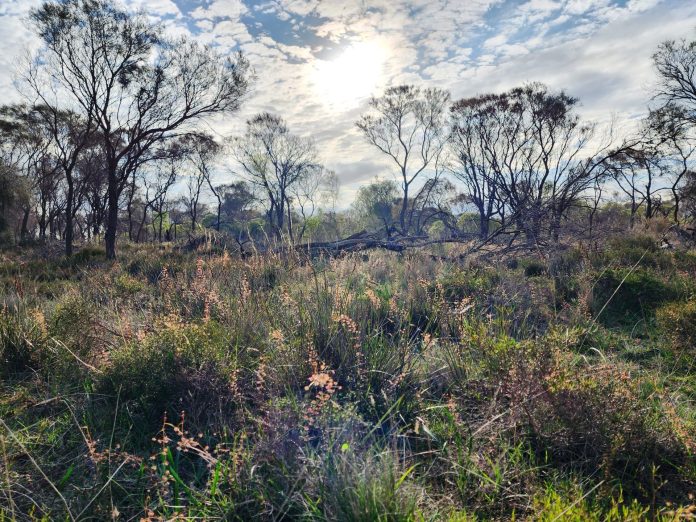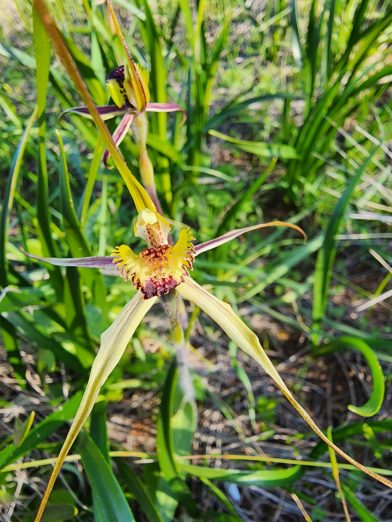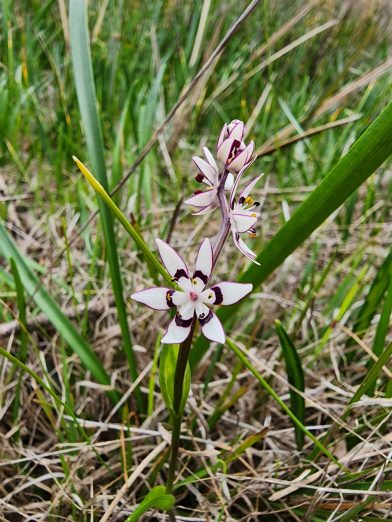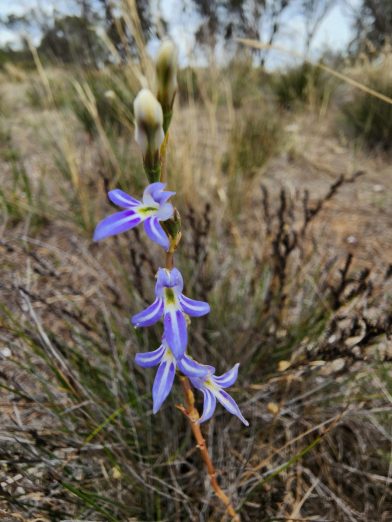Natural Heritage Manager Alex Emmins shares her excitement about encountering rare birdlife and carpets of spring wildflowers during a recent visit to Mulbura Park Reserve – a precious pocket of bushland on Yorke Peninsula.
Mulbura Park is one of my absolute favourite nature reserves. The diversity of flora and fauna, the condition of the vegetation and the sheer number of native orchids to be found there in the spring, make it a very special place. Then there are the unexpected encounters. During my last visit I was fortunate to see my first crested bellbird in the wild as I stood quietly listening to the sound of drooping she-oaks in the wind, followed by a pair of nesting brown falcons bringing back a bearded dragon for their chicks to feast on.
Surrounded by cropping country about 10 kilometres north of Port Vincent, Mulbura Park sits on the land of the Narungga (traditionally spelled Nharangga) people. Comprising 19 hectares of remnant drooping she-oak (Allocasuarina verticillata) woodland and Mallee (Eucalyptus socialis), it conserves an extremely valuable vegetation type, of which only an estimated 2% remains. This type of grassy woodland on calcrete is listed as Critically Endangered in what is known as the Eyre Yorke Block – a bioregion that extends across both Eyre and Yorke peninsulas, where much of the land was historically cleared for agriculture, especially on Yorke Peninsula with its relatively flat terrain and fertile soils making it primate farming land. In fact, it’s recognised as the most cleared region in the state.
At least 136 indigenous plant species have been identified within the woodland, of which one species is endangered, another is vulnerable, and 10 are rare on Yorke Peninsula. Among the rare species found at the reserve is the coast spider-orchid (Caladenia conferta). The near-threatened upright spider-orchid (Caladenia stricta) can be found here too. Five bird species of Regional Conservation Significance have also been observed in the park, as well as less common species such as the painted buttonquail, white-fronted chat, purple-backed fairywren, hooded robin and Jacky winter.
The drooping she-oak is ecologically and culturally important to many First Nations people. Its strong timber is used to make tools such as boomerangs and shields – the oldest known surviving boomerang was made from a drooping she-oak in South Australia approximately 11,000 years ago! The seeds and immature cones provide a source of vitamin C and can be used to make flour; and the dropped needles made a soft bed for infants. The tree’s spiritual significance is also profound; the wind blowing through its branches carries ancestral voices and provides a connection to them. The tree also supports the ecosystem, enriching the soil by fixing nitrogen and providing habitat for animals, including many threatened species.
The Southern Yorke Peninsula Landcare Group assists with weed control in Mulbura Park, focussing in particular on bridal creeper, African boxthorns and weedy acacias. However, the reserve remains largely weed-free thanks to decades of work from dedicated volunteers!
The best time to visit is during spring when the wildflowers are in full bloom. If you’re fortunate to experience Mulbura Park then, you’ll wonder where to place your next step amongst the carpet of orchids, lilies and other small ephemerals! Sundews are prolific in the reserve and at the right time of day glisten spectacularly across the whole park. And did you know that before European occupation, native orchid flowers were the most prolific flower on Yorke Peninsula? After visiting Mulbura Park you will certainly appreciate that this is true. If you’re lucky you may even spot a rare species or two!
Digby Germein
Mulbura Park was gifted to the National Trust in 1975 by Yorke Peninsula farmer Digby Clifford Germein (1913-1990), a descendent of the Germein family, who played a significant part in South Australia’s maritime history. His grandfather, Captain John Germein, spent many years in the pilot service and commanded the coastal steamer Ceres, which traded between Yorke Peninsula and Port Adelaide.
The reserve was part of land acquired by Digby’s father, Perce Germein, who moved to the area as a young man and married Ethel Gregor of Curramulka. Born in 1913, Digby was the fourth of six children. According to his son, Colin, he decided to gift Mulbura Park to the National Trust because it was good natural scrubland that had never been cleared. “He loved going for walks in the scrub and enjoying nature,” Colin recalls.
Digby was encouraged by his cousin, Reg Sprigg, the renowned geologist and conservationist, who officially opened the park at a ceremony arranged by the Minlaton and District Branch on 28 August 1977. Digby chose the name because he understood Mulbura to be an Aboriginal word pertaining to the area.








